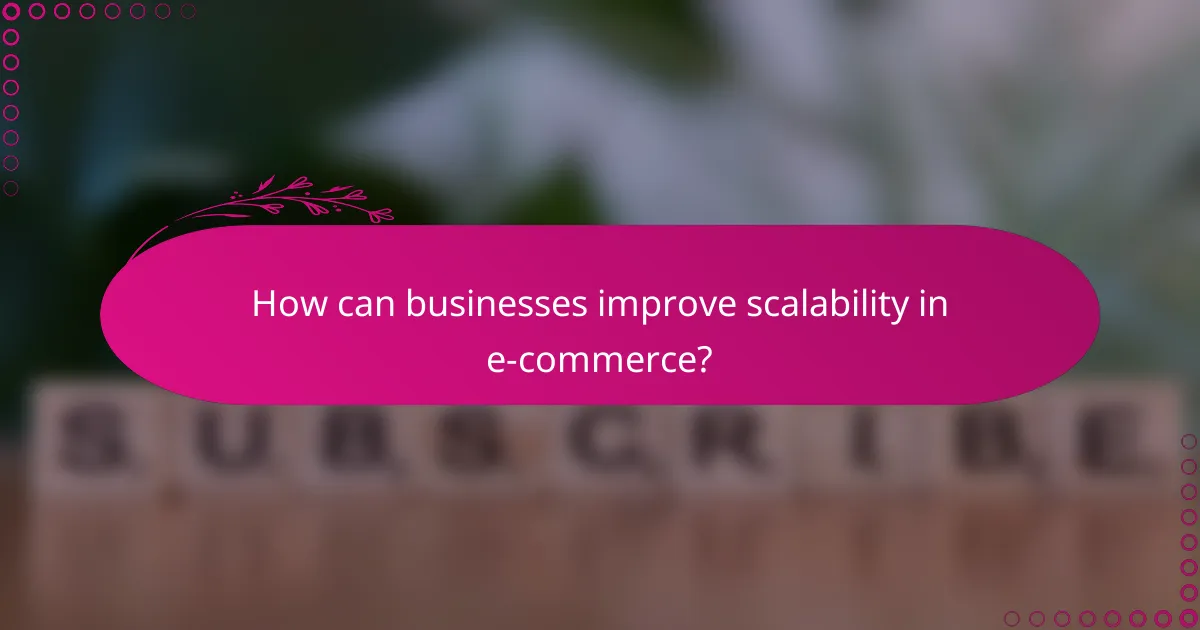E-commerce solutions face several critical challenges, including payment security risks, platform dependency, and scalability issues. Payment security risks can expose businesses to unauthorized access to sensitive financial information, potentially leading to significant financial losses and reputational damage. Additionally, reliance on specific platforms can create operational vulnerabilities and limit customization, while scalability issues may hinder growth as demand fluctuates. Addressing these concerns is essential for maintaining a secure and efficient online business environment.

What are the payment security risks in e-commerce?
Payment security risks in e-commerce primarily involve vulnerabilities that can lead to unauthorized access to sensitive financial information. These risks can result in significant financial losses and damage to a business’s reputation if not properly managed.
Data breaches
Data breaches occur when unauthorized individuals gain access to sensitive customer information, such as credit card numbers and personal details. These incidents can happen due to weak security measures, outdated software, or phishing attacks targeting employees.
To mitigate the risk of data breaches, businesses should implement strong encryption methods, regularly update their security protocols, and conduct employee training on recognizing potential threats. Regular security audits can also help identify vulnerabilities before they are exploited.
Fraudulent transactions
Fraudulent transactions involve unauthorized purchases made using stolen payment information. This type of fraud can be particularly damaging to e-commerce businesses, leading to chargebacks and financial losses.
To reduce the risk of fraudulent transactions, e-commerce platforms should utilize advanced fraud detection tools that analyze transaction patterns and flag suspicious activities. Implementing two-factor authentication can also add an extra layer of security for both customers and merchants.
Compliance failures
Compliance failures refer to the inability to adhere to regulations governing payment security, such as the Payment Card Industry Data Security Standard (PCI DSS). Non-compliance can result in hefty fines and legal repercussions.
To ensure compliance, businesses should familiarize themselves with relevant regulations and regularly review their payment processes. Engaging with compliance experts or using certified payment processors can help maintain adherence to necessary standards and reduce the risk of penalties.

How can e-commerce businesses mitigate payment security risks?
E-commerce businesses can mitigate payment security risks by implementing robust security measures such as encryption, tokenization, and regular security audits. These strategies help protect sensitive customer data and maintain trust in online transactions.
Implementing encryption technologies
Encryption technologies secure sensitive data by converting it into a coded format that can only be read by authorized parties. E-commerce platforms should use protocols like TLS (Transport Layer Security) to encrypt data during transmission, ensuring that customer information remains confidential.
Additionally, businesses should consider end-to-end encryption for payment processing, which protects data from the point of entry to the final transaction. This approach minimizes the risk of data breaches and enhances customer trust.
Utilizing tokenization
Tokenization replaces sensitive payment information with unique identifiers, or tokens, that have no exploitable value. This means that even if a data breach occurs, the stolen data is useless to cybercriminals.
Implementing tokenization can significantly reduce the scope of PCI DSS (Payment Card Industry Data Security Standard) compliance, as fewer sensitive data elements are stored. E-commerce businesses should partner with payment processors that offer tokenization services to enhance their security posture.
Regular security audits
Conducting regular security audits helps identify vulnerabilities in an e-commerce platform’s payment systems. These audits should include assessments of encryption methods, tokenization processes, and overall compliance with security standards.
Businesses should schedule these audits at least annually, or more frequently if significant changes occur in their systems or operations. Engaging third-party security experts can provide an objective evaluation and help implement necessary improvements to mitigate risks effectively.

What are the implications of platform dependency in e-commerce?
Platform dependency in e-commerce refers to the reliance on a specific software or service provider for online business operations. This can lead to various challenges, including vendor lock-in, limited customization options, and increased operational risks.
Vendor lock-in
Vendor lock-in occurs when a business becomes overly reliant on a specific e-commerce platform, making it difficult to switch to another provider without incurring significant costs or disruptions. This can limit a company’s flexibility and adaptability in a rapidly changing market.
To mitigate vendor lock-in, consider using open-source platforms or those that support data portability. This allows for easier migration of data and services if you decide to change providers in the future.
Limited customization options
Many e-commerce platforms offer predefined templates and features that may not fully meet a business’s unique needs. This limitation can hinder the ability to create a tailored shopping experience for customers, impacting sales and customer satisfaction.
To enhance customization, evaluate platforms that provide robust APIs or allow third-party integrations. This can enable businesses to implement specific functionalities that align with their brand and operational requirements.
Increased operational risks
Relying on a single e-commerce platform can expose businesses to various operational risks, such as service outages, security vulnerabilities, and compliance issues. If the platform experiences downtime or data breaches, it can directly affect sales and customer trust.
To reduce these risks, regularly assess the platform’s security measures and uptime performance. Additionally, consider implementing backup solutions and diversifying your online presence across multiple platforms to ensure business continuity.

How to choose the right e-commerce platform?
Choosing the right e-commerce platform involves evaluating its scalability, integration capabilities, and pricing models. A well-suited platform can support your business growth while ensuring seamless operations and cost-effectiveness.
Assessing scalability features
Scalability refers to a platform’s ability to handle increased traffic and transactions as your business grows. Look for platforms that offer flexible hosting solutions, allowing you to upgrade resources easily during peak seasons or sales events.
Consider platforms that provide cloud-based services, which typically offer better scalability compared to traditional hosting. A good rule of thumb is to choose a platform that can support at least double your current traffic projections.
Evaluating integration capabilities
Integration capabilities are crucial for connecting your e-commerce platform with other tools like payment gateways, inventory management systems, and CRM software. Ensure the platform supports popular integrations that suit your business needs.
Check for APIs and plugins that facilitate easy connections with third-party applications. Platforms that offer extensive marketplaces for integrations can save you time and reduce the complexity of managing multiple systems.
Comparing pricing models
Pricing models vary significantly among e-commerce platforms, including monthly subscriptions, transaction fees, or a combination of both. Analyze your budget and expected sales volume to determine which model aligns best with your financial goals.
Some platforms may offer lower upfront costs but higher transaction fees, while others might charge a flat monthly rate. It’s essential to calculate potential total costs over time, factoring in growth projections to avoid unexpected expenses.

What are the scalability issues faced by e-commerce platforms?
E-commerce platforms often encounter scalability issues that can hinder their growth and performance. These challenges include managing performance bottlenecks, handling high traffic, and addressing cost implications associated with scaling operations.
Performance bottlenecks
Performance bottlenecks occur when the system cannot handle the volume of transactions efficiently, leading to slow response times and potential downtime. Common causes include inadequate server resources, poorly optimized code, and database limitations.
To mitigate these bottlenecks, consider implementing load balancing, optimizing database queries, and utilizing caching strategies. Regular performance testing can help identify weak points before they affect users.
High traffic management
High traffic management is crucial for e-commerce platforms, especially during peak shopping seasons or promotional events. Platforms must ensure they can accommodate sudden surges in users without compromising performance.
Strategies for managing high traffic include using Content Delivery Networks (CDNs) to distribute load, employing auto-scaling solutions, and preparing for traffic spikes with stress testing. Planning for high traffic can prevent crashes and maintain a positive user experience.
Cost implications
Scaling an e-commerce platform often comes with significant cost implications, including increased hosting fees, additional software licenses, and potential staffing needs. As demand grows, so do the expenses associated with maintaining and upgrading infrastructure.
To manage costs effectively, consider adopting a cloud-based solution that allows for flexible scaling based on demand. Additionally, regularly reviewing and optimizing resource usage can help control expenses while ensuring adequate performance.

How can businesses improve scalability in e-commerce?
Businesses can enhance scalability in e-commerce by adopting flexible technologies and strategies that allow them to efficiently manage increased traffic and transactions. This involves leveraging cloud-based solutions and implementing load balancing techniques to ensure optimal performance during peak periods.
Cloud-based solutions
Cloud-based solutions provide businesses with the ability to scale their resources up or down based on demand. By utilizing services from providers like AWS, Google Cloud, or Microsoft Azure, companies can avoid the costs of maintaining physical servers while benefiting from high availability and redundancy.
When choosing a cloud provider, consider factors such as pricing models, service level agreements (SLAs), and geographic data center locations. This ensures that your e-commerce platform remains responsive and reliable, even during traffic spikes.
Load balancing strategies
Load balancing strategies distribute incoming traffic across multiple servers, preventing any single server from becoming overwhelmed. This can be achieved through hardware load balancers or software solutions like NGINX or HAProxy, which help maintain performance and uptime.
Implementing load balancing requires careful planning, including selecting the right algorithms (like round-robin or least connections) and monitoring server health. Regularly testing your load balancing setup can help identify potential bottlenecks and ensure a seamless shopping experience for customers.
